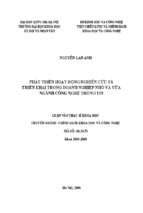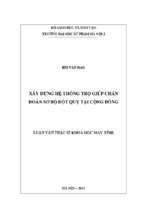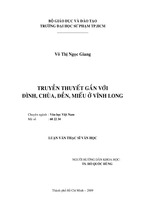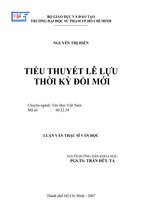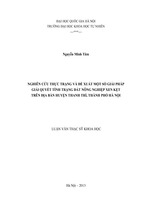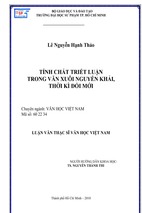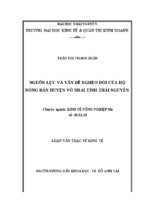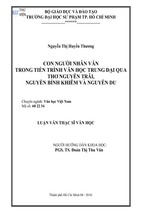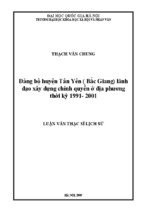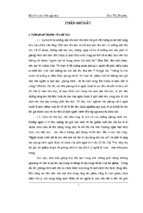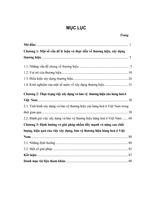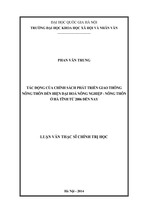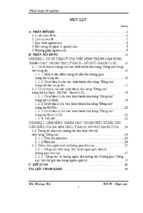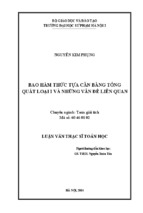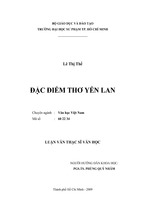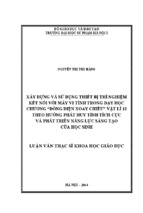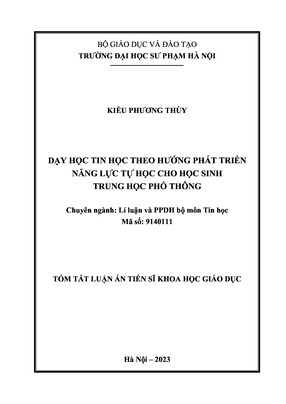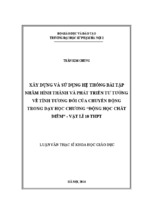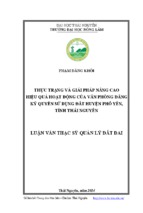1
2
MINSTRY OF EDUCATION AND TRAINING
This study has been completed at the College of foreign languages,
UNIVERSITY OF DANANG
NGUYỄN LÊ THỤC NHÃ
University of Danang
Supervisor: TRƯƠNG BẠCH LÊ, Ph. D.
Examiner 1: NGUYỄN THỊ QUỲNH HOA, Ph. D.
HOW TO DELIVER BAD NEWS
IN ENGLISH AND IN VIETNAMESE
Examiner 2: NGUYỄN QUANG NGOẠN, Ph. D.
Field study : THE ENGLISH LANGUAGE
Code
:
60.22.15
The thesis was orally presented at the Examining Committee at the
University of Danang
M.A. THESIS IN THE ENGLISH LANGUAGE
(A SUMMARY)
Time
: 5th November, 2011
Venue : University of Danang
* The thesis is accessible for the purpose of reference at:
DANANG- 2011
- Library of the College of Foreign Languages, University of Danang
- The University of Danang Information Resources Centre
3
CHAPTER 1
INTRODUCTION
1.1 BACKGROUND AND RATIONALE
Sharing bad news is part of everyday life. Bad news is not
4
1.2 PURPOSES OF THE STUDY
This study is aimed at providing learners of English with
syntactic and pragmatic features of delivering bad news. Then the
similarities and differences are pointed out.
limited to death alone. It may be bad news from the doctor, telling
1.3 JUSTIFICATION FOR THE STUDY
one their disease is terminal. It may be bad news from the corporation
1.4 SCOPE OF THE STUDY
or business, or factory informing one about an upcoming layoff
The study deals with the description and analysis of the
which will include the person being informed. It may be the bad
syntactic and pragmatic features of the languages used to deliver bad
news that a child is failing in school, or news about an accident. It
news in spoken discourse in English and Vietnamese. Bad news in
may be anything that upsets your emotions in a drastic way.
this study refers to real bad news based on the context in which it
No one enjoys delivering bad news, but at one time or another,
appears. This study does not mention bad news as “ good news” in
people will be faced with the unpleasant task of having to deliver bad
many cases. The situations which are studied in this thesis are limited
news. Bad-news messages must be delivered carefully, with the
to family, school and business life. This study does not include non-
ultimate goal being acceptance of the message by those to whom it is
verbal forms such as gestures or facial expressions either.
directed.
1.5 RESEARCH QUESTIONS
1) What are the syntactic features of the language used to
Different cultures have different values, especially in
communication. Each culture has its own rules in communication, so
learners of a foreign language should master these rules so that they
can avoid communication breakdowns or cultural shocks. Delivering
bad news is such a sensitive task. How to deliver bad news naturally
requires learners much knowledge of the language. Above are the
deliver bad news in English and in Vietnamese?
2) What are the pragmatic features of the language used to
deliver bad news in English and in Vietnamese?
3) What are the syntactic and pragmatic similarities and
differences between English and Vietnamese in delivering bad news?
main reasons that motivate me to carry out this research paper, “
How to Deliver Bad News in English and Vietnamese”. We do hope
1.6 ORGANIZATION OF THE STUDY
that the study will provide both English and Vietnamese learners with
The research paper is divided into five chapters.
Chapter 1, “ Introduction”, includes the rationale, purposes of the
useful knowledge to improve their communicative competence.
study , justification for the study ,research questions, scope of the
study and organization of the study. The Definition of “bad news” is
also in this chapter.
5
6
Chapter 2, “ Literature review”, consists of review of prior
CHAPTER 2
research and related theoretical background knowledge.
Chapter 3, “ Method and Procedure”, presents the aims and
objectives, research design and methodology, selection of sample as
well as data collection, data analysis and reliability and validity.
Chapter 4, “ Discussions of Findings” , looks into the
syntactic and pragmatic features of the language used to deliver bad
LITERATURE REVIEW
2.1 A REVIEW OF PREVIOUS STUDIES
There have been a great deal of studies on speech acts. These
includes apologies, complaints, compliments, invitations, requests,
refusals.etc
Austin, J. L. (1962), How to Do Things with Words,[9] , Yule,
G. (1996), Pragmatics [38] and Nguyễn Đức Dân (1998), Ngữ dụng
news in English and in Vietnamese. Then the similarities and
học- Tập 1 [4] talk about speech acts and mention locutionary,
differences between English and Vietnamese will be withdrawn.
illocutionary and perlocutionary acts and makes distinction between
Chapter 5, “Conclusions and Implication”, summarizes the
development of the study as well as the findings of the study and
works out the implications for the teaching and learning of delivering
illocutionary and perlocutionary acts.
Brown,P. and Levinson, S.(1990) and Nguyễn Quang (2004)
discussed the politeness strategies.
bad news in English and in Vietnamese. Some limitations of the
Some recent cross-lingual studies did a research into speech
study are pointed out and suggestions for further research are
acts such as Tran Thi My Linh (2006), “A Vietnamese-English cross-
provided in this chapter.
cultural study of the use of hedging before giving bad news” [33,
Truong Thi Phuong Trang (2001), “ A Study on Politeness Strategies
1.7 DEFINITION OF “BAD NEWS”
in Disagreement” [34],
Truong Thi Anh Tuyet (2003), “A Study on
Cross-Cultural Pragmatics Failure of Invitation in English versus
Vietnamese” [35], Le Thi Bang Tam (2006), “A Study of English
and Vietnamese Negative Comments” [24].
It can be seen that each author mentions certain aspects of speech
acts, such as syntactic, semantic or pragmatic features of
disagreements, invitations, negative comments…
In this thesis, both syntactic and pragmatic features of delivering bad
news will be described and analyzed. A contrastive analysis between
English and Vietnamese in delivering bad news is also carried out to
7
8
provide learners with specific knowledge, which can help better their
2.2.2.2 Direct and Indirect Speech Act
communication competence.
Searle [29] said that a speaker using a direct speech act wants
2.2 THEORETICAL BACKGROUND
to communicate the literal meaning that the words conventionally
2.2.1 Syntactic Structure
express; there is a direct relationship between the form and the
2.2.2 Speech act Theory
function. On the other hand, he explained that people can also
2.2.2.1 Speech Acts
communicate a different meaning from the apparent surface meaning
The theory of speech acts has been paid much attention on.
by using indirect speech act.
There have been a lot of theorists studying this matter such as Austin
Jenny Thomas [32] discussed the four points of indirectness:
(1962), Grice (1975), Hymes (1964), Levinson (1983), Brown and
1. Intentional indirectness
Yule (1983), Searle (1975).etc.
2. Indirectness is costly and risky
Austin [9] points out that in issuing an utterance, a speaker can
3. Assumption of rationality
perform three acts simultaneously: Locutionary act, Illocutionary
4. The principle of Expressibility
act, Perlocutionary act
2.2.3 Conversational Implicature
In “ How to do things with words” , Austin [9] classified
speech
acts
into
five
categories:
Verdictives,
Exercitives,
Commissives, Behavitives, and Expositives.
Grice [20] outlined an approach to what he termed
conversational implicature .The conversational implicature is a
message that is not found in the plain sense of the sentence. The
Searle (1976) [29] and Yules (1996) [41] states that the five
speaker implies it. The hearer is able to infer this message in the
kinds of speech acts are: Assertives or Representatives, Declaratives,
utterance
Expressives, Commissives and Directives:
conversational interaction.
Bach and Harnish (1984) [10] classified speech acts into four
categories:
Constatives,
Directives,
Commissives
and
Acknowledgements.
by
appealing
to
the
rules
governing
successful
2.2.4 Cooperative Principles
Paul Grice [20] proposes that in ordinary conversation,
speakers and hearers share a cooperative principle. Speakers shape
From the classification of speech acts made by Searle and
their utterances to be understood by hearers. The principle can be
Yule, it can be seen that delivering bad news relates to
explained by four underlying rules or maxims. They are the maxims
Representatives speech acts. They consist of assertions, reports,
of quality, quantity, relevance and manner.
conclusions, description etc. Delivering bad news means informing
or announcing someone about something bad. It belongs to reporting
acts.
9
10
2.2.5 Politeness Theory
2.2.5.4 Politeness Strategies
2.2.5.1 Face
a. Bald-on Record
Face is something that can be lost, maintained or enhanced and
These provide no effort by Ss to reduce the impact of the
must be constantly attended to in interaction. There are two aspects to
FTA's. Ss will most likely shock the person to whom they are
this self image.
speaking to, embarrass them, or make them feel a bit uncomfortable.
- Positive face:
b. Positive Politeness
- Negative face:
Positive politeness is oriented toward the positive face of H.
2.2.5.2 Face Threatening Acts (FTAs)
Positive politeness minimizes the threatening action by reassuring
According to Brown and Levinson [12], a face threatening act
the H that he or she is valued by the S, that somehow the S wants
is an act that inherently damages the face of the addressee or the
speaker by acting in opposition to the wants and desires of the other.
2.2.5.3 Politeness Strategies for Doing FTA
what the H wants, or that they are members of the same-in-group.
c. Negative Politeness
Negative politeness strategies are oriented towards the
In communication Ss tend to avoid FTAs, and they employ
hearer’s negative face and emphasize avoidance of imposition on the
certain strategies to minimize the threat. Brown and Levinson
hearer. These strategies presume that the speaker will be imposing
[12,p19] made it clearer in Figure 1.
on the listener and there is a higher potential for awkwardness or
embarrassment than in bald on record strategies and positive
politeness strategies.
d. Off-record
Without redressive action
On record
Do the FTA
positive politeness
to say something directly, he can do it off-record.
With redressive action
Off record
Off- record strategies means indirect ones. If S does not want
negative politeness
2.2.5.5 Factors Influencing the Choice of Strategies
Brown and Levinson [12] also point out three sociological
Don’t do the FTA
factors which speakers should take into consideration when deciding
whether and how to use the various strategies in real life situations:
Figure 2.1 Possible Strategies for Doing FTAs
Social distance between parties (symmetric relation) , Power relations
between parties (a symmetric relation) , The absolute ranking of the
threat of the FTA.
11
12
CHAPTER 3
House and Kasper (1989) in their Cross-Cultural Speech Act
METHODS AND PROCEDURES
3.1 AIMS AND OBJECTIVES
3.1.1 Aims of the Study
The study is aimed at finding the possible similarities and
differences between English and Vietnamese in delivering bad news.
3.1.2 Objectives of the Study
- Identify the syntactic and pragmatics features of how to
deliver bad news in English and in Vietnamese.
- Find out the possible similarities and differences between
English and Vietnamese in delivering bad news.
- Suggest some implications for the teaching and learning of
how to deliver bad news in English and in Vietnamese.
3.2 RESEARCH DESIGN AND RESEARCH METHOD
The study makes use of the following methods: contrastive,
qualitative and quantitative analysis.
3.3 SELECTION OF THE SAMPLE
About 200 samples for each language are chosen to be
analyzed in the study. The source of data is mainly collected from
extracts of conversations in English and Vietnamese short stories,
novels and films
3.4 DATA COLLECTION
3.4.1 Data Collection from Document Reviews
As mentioned above, the data were collected from stories,
novels, films as well as on the TV and the Internet in English and
Vietnamese.
3.4.2 Data Collection from the Survey Questionnaire
Realisation Project (CCSARP) [11]. The questionnaire is designed
The data were collected by means of a standard questionnaire
called discourse completion test (DCT). It was used by Blum-Kulka,
with ten situations as follows:
What do you say to deliver bad news verbally
in the
following situations?
Situation 1: You want to inform about the death of the hearer’s
relative .
Situation 2: You want to inform about an accident in which the
hearer’s relative was badly injured:
Situation 3: You want to inform that the hearer/ the hearer ‘s
relative has got a serious disease.
Situation 4: You want to inform about the hearer’s / the hearer
‘s relative’s loss of money or precious property ( car/ motorbike/ …)
Situation 5: You want to inform about the hearer’s / the hearer
‘s relative’s failure in applying for a job
Situation 6: You want to inform that the hearer‘s relative has
been arrested for a crime.
Situation 7: You want to inform that the hearer/ the hearer ‘s
relative has been tricked into buying a fake thing .
Situation 8: You want to inform that the hearer/ the hearer‘s
relative has failed an examination.
Situation 9: You want to inform that the hearer/ the hearer ‘s
relative has been fired
Situation 10: You want to inform about the marriage break-up
of the hearer’s relative
Each respondent was expected to give 60 utterances. As the
questionnaire were delivered to 30 speakers of Vietnamese and 30
people from English speaking countries, we expect to have about
13
14
1800 utterances for each language. Together with 200 utterances
4.1.2.2 Negation
collected from books, novels and films, the utterances to be analyzed
a. English negation
may reach 2000 utterances for each language.
b. Vietnamese negation
3.5 DATA ANALYSIS
4.1.2.3 Question
The utterances which are used to deliver bad news are analyzed
a. English question
and classified to find out syntactic and pragmatic features.
b. Vietnamese question
3.6 RELIABILITY AND VALIDITY
4.1.2.4 Existential Sentences
a. English Existential sentences
CHAPTER 4
RESULTS AND DISCUSSION
4.1 SYNTACTIC FEATURES OF DELIVERING BAD NEWS
IN ENGLISH AND IN VIETNAMESE
b. Vietnamese Existential sentences
4.1.2.5 Conditional Structure
a. English Conditional structure
b. Vietnamese Conditional structure
4.1.1 Phrasal Structures
4.1.2.6 Passive Voice Structure
4.1.1.1. Noun phrases
a. English Passive voice structure
a. English noun phrases
b. Vietnamese Passive voice structure
b. Vietnamese noun phrases
4.1.3 Clausal Structure
4.1.1.2 Prepositional Phrases
4.1.3.1 English Clauses of Reason
4.1.1.3 Verb Phrases
4.1.3.2 Vietnamese Clauses of Reason
a. English verb phrases
4.1.4 Discussion of the Similarities and Differences in the
b. Vietnamese verb phrases
Syntactic Features of Delivering Bad News in English and in
4.1.1.2. Adjective Phrases
Vietnamese
a. English Adjective phrases
b. Vietnamese Adjective phrases
4.1.2 Sentential Structures
4.1.4.1 Similarities in the Syntactic Features of Delivering
Bad News in English and in Vietnamese
In both languages such structures as noun phrases, adjective
4.1.2.1 Statement
phrases, verb phrases, statement, negation, questions, existential
a. English statement
sentences, conditional structures, passive voice structures and clauses
b. Vietnamese statement
of reason are used to convey bad news.
15
16
As for phrasal structures, most phrases have equivalent
Another difference is bad news can be implied through
structures in both languages. They may be a one-element phrase or
English Wh-questions whereas in Vietnamese they are not used.
may contain premodifier or/and postmodifier.
Alternative questions are found in our Vietnamese corpus, but not in
As for statement, bad news in the form of performative verbs is
used in both English and Vietnamese. Besides, such typical types of
sentences as SV, SVO, SVC, SVA, SVOO, SVOA have been found.
Equivalent structures in negation, questions, existential
sentences, conditional structures, passive voice structures and clauses
of reason are also used in the two languages.
4.1.4.2 Differences in the Syntactic Features of Delivering
Bad News in English and in Vietnamese
Firstly, in Vietnamese no preposition phrases have been found
while in English such phrases are used.
Secondly, Vietnamese makes full use of modal particles (rồi,
English one.
Last but not least, in English an inversion may exist in
conditional structures. Meanwhile, such structures can not be
inversed in Vietnamese.
4.2 PRAGMATIC FEATURES OF DELIVERING BAD NEWS
IN ENGLISH AND IN VIETNAMESE
4.2.1 Bald-on Record
4.2.2 Positive Politeness
4.2.2.1 Noticing/ Attending to H (interests, wants, needs,
goods)
4.2.2.2 Exaggerating (interest, approval, sympathy with H)
lắm, ñấy…) to express modality whereas in English such types of
4.2.2.3 Using in-group identity markers
word do not exist.
4.2.2.4 Avoiding disagreement
Thirdly, in verb phrases, Verb-ing forms can only be found in
English, not in Vietnamese because words in Vietnamese don’t
change their forms under any circumstances.
Fourthly, in statement the type SVOC has only been found in
4.2.2.5 Presupposing/ raising/ asserting common ground
4.2.2.6 Asserting or Presupposing S’s Knowledge of and
Concern for H’s wants
4.2.2.7 Including both S and H in the Activity
Vietnamese samples. Moreover, the big difference between the
4.2.3 Negative Politeness
sentence types of the two languages is that in English sentences the
4.2.3.1 Being Conventionally Indirect
verbs act as the predicate and they are indispensable. In Vietnamese,
4.2.3.2 Hedging
the predicate of a sentence may be an adjective or a noun.
a. Quality Hedges
Fifthly, negation in English has been found with more
b. Relevance Hedges
structures than in Vietnamese. Such structures as TOO…TO,
4.2.3.3 Being Pessimistic
LITTLE, FEW are hardly found in our Vietnamese corpus.
4.2.3.4 Minimizing the Imposition
4.2.3.5 Giving deference
17
18
4.2.3.6 Apologizing
Vietnamese. This pronoun, which may be used to refer to H only, can
4.2.3.7 Impersonalizing S and H
reduce the distance between S and H. Moreover it can carry the
4.2.3.8 Nominalizing
meaning of inclusive “we” to indicate that S and H belong to one
4.2.4 Off-record
group, thus can reduce the FTA of bad news delivery. Another
4.2.4.1 Giving Association Clues
similarity is that cajolers “you know, you see” and Vietnamese
4.2.4.2 Understating
equivalents “Anh/chị biết không, Anh /chị thấy ñấy…” and negative
4.2.4.3 Being Ironic
questions have the functions of supposing/ asserting common ground
4.2.4.4 Using Rhectorical Questions
between S and H. What is more, S may assert his knowledge and
4.2.5 Result and Discussion on Survey Questionnaire
show concern for H’s wants through negative questions and
4.2.6 Discussion of the Similarities and Differences in the
expressions like “ I know, I‘m aware that, Tôi biết…”.
Pragmatic Features of Delivering Bad News in English and in
Vietnamese
4.2.6.1 Similarities in the Pragmatic Features of Delivering
Bad News in English and in Vietnamese
Both languages apply bald-on record, positive politeness,
negative politeness and off-record strategies.
Bald-on record strategies are popular both in English and
Vietnamese when S has to convey the news in emergency.
As for negative politeness strategies, both English and
Vietnamese adapt hedges such as “ It seems, People say that, It is
said that… (Hình như , Người ta nói là, Người ta ñồn là…)” to
minimize the exactness of the utterance or hedges to show S’s regret
such as “ I’m afraid, It’s a pity, Tôi e là, Tôi rất tiếc…”. Moreover,
S can show his uncertainty of the utterance by using “ Perhaps” in
English and “ Chắc, Có lẽ” in Vietnamese, or S can use “just” (chỉ)
to minimize the imposition so that H’s negative face can be saved.
With reference to positive politeness strategies, some sub-
When H is of higher social status than S, such honorifics as “
strategies are adapted in the two languages. Most English and
Sir, Madam, Mr.” and equivalents in Vietnamese as “ Ông, bà, Ngài,
Vietnamese Ss notice H’s interest or wants when delivering bad
Anh, Chị…” are used to address before bad news to make the
news. Hedges referred to H’s condition such as health, reputation or
utterance more formal and to show that S give deference to defuse
finance are mentioned before bad news is given. Besides, emphasis
FTA. S can also express his reluctance or regret when conveying bad
words are also used to exaggerate the news in the two languages.
news by using such expressions as “ I’m sorry, I regret to inform you
Both English and Vietnamese employ in-group identity markers such
that, I take it as a regret to inform you that…” in English and “ Tôi
as terms of address or generic names or proper names as well as
xin lỗi, Tôi rất tiếc phải báo cho anh biết là…”. Ss of both languages
slang or jargon to show the common ground between S and H. The
can also minimize the FTA by avoiding the pronoun I and You by
merging of “I” and “you” into “we” appears in both English and
19
20
omitting performative verbs, or pluralizing the you and I pronouns, or
Ss often show their reluctance when doing such an FTA as delivering
addressing terms as you avoidance, or using point of view distancing.
bad news by hedges “ I hate to tell you this but, I hate to break to
With reference to off record strategies, both English and
you this way but…”. These hedges are not found in Vietnamese.
Vietnamese Ss can deliver bad news indirectly by giving association
Another difference is that when English Ss want to impersonalize S
clues and Hs have to infer the news. Another strategy that is
and H in conveying bad news, they can use passive voice structures
employed in both languages is using understating expressions like “
or use point of view distancing (switching the tense form present into
sort of, hardly, khó…”. Rhectorical questions can also be used to
past). Moreover, nominalizing is popular in English to make the
convey bad news indirectly in English and Vietnamese.
utterance more formal; therefore it is employed in delivering bad
4.2.6.2 Differences in the Pragmatic Features of Delivering
Bad News in English and in Vietnamese
Although the two languages have a lot of similarities,
differences seem to appear in sub-strategies.
As for Positive politeness strategies, English Ss may avoid
disagreement by using “kind of, sort of” to make his opinion safely
vague, but in Vietnamese this strategy can hardly be found.
To presuppose/ raise/ assert common ground, the merging of
news. Meanwhile, in Vietnamese such strategy does not exist. The
difference also appears in the use of pronoun. Vietnamese Ss may
replace the pronoun “I” and “you” with the indefinite “Người ta”. In
English, there is equivalent indefinite pronoun “One”, but it is not
found in our corpus.
In terms of off-record strategies, English Ss are often not ironic
when delivering bad news, but Vietnamese Ss are. They sometimes
deliver bad news with irony when the relationship between the S and
“I” and “you” into inclusive “we” is used in both languages, but just
H is not good and S wants to ridicule H.
in Vietnamese this kind of merging is used with possessive adjectives
4.3 FREQUENCY OF ENGLISH AND VIETNAMESE WAYS
(as in “Em Thu nhà mình” ) to refer to H’s relative. One distinctive
feature of the Vietnamese language is that the possessive adjective
may be omitted when S wants to imply that S considers H’s relative
his.
With respect to negative politeness strategies, “being
conventionally indirect” appears in English only. It can be expressed
by “ I’m wondering if, I was wondering if, I wondered if …”. In our
Vietnamese corpus such expressions do not exist. Besides, In English
apologizing strategy is used very often in delivering bad news
whereas in Vietnamese it is used less frequently. Moreover English
OF DELIVERING BAD NEWS
4.3.1. Frequency of English and Vietnamese Ways of
Delivering Bad News in Syntactic Categories
21
22
Table 4.3 Frequency of English and Vietnamese Ways of
Table 4.4 Frequency of English and Vietnamese Ways of
Delivering Bad News in Syntactic Categories
Delivering Bad News in Pragmatic Categories
English
Vietnamese
Occurence Percentage Occurence Percentage
(%)
Strategies
(%)
Bald-on
record
Sub-strategies
Phrasal
Noun phrase
64
3.20
49
2.45
structures
Verb phrase
19
0.95
77
3.85
Noticing/Atten
Adj phrase
33
1.65
20
1.00
ding to H
1
0.05
0
0
Prepositional
phrase
Positive
politeness
5.85
146
7.30
approval/
Sentential Statement
935
46.75
944
47.20
sympathy with
structures
Negation
268
13.40
239
11.95
H)
Question
147
7.35
115
5,75
Using in-group
98
4.90
75
3.75
375
18.75
401
20.05
27
1.35
35
1.75
1850
92.50
1809
90.45
33
1.65
45
2.25
ground
2000
100
2000
100
Asserting/
sentences
Passive voice
structures
Conditional
structure
Subtotal
reason
Total
408
20.40
376
18.80
115
5.75
159
7.95
47
2.35
46
2.30
120
6.00
245
12.25
2
0.10
0
0
157
7.85
270
13.50
3
0.15
7
0.35
identity
Existential
structures
Occurence Percentage Occurence Percentage
(interest/
117
Clauses
Vietnamese
Exaggerating
Subtotal
Clausal
English
of
markers
Avoiding
disagreement
Presupposing/
Raising/
Asserting
common
4.3.2 Frequency of English and Vietnamese Ways of
Delivering Bad News in Pragmatic Categories
Presupposing s’
knowledge
of
and concern for
H’s want
23
Including both
85
24
4.25
157
7.85
CONCLUSIONS, IMPLICATIONS AND
S and H in the
RECOMMENDATIONS
activity
Sub-total
529
26.45
884
44.20
Being
17
0.85
0
0
5.1 SUMMARY OF THE DEVELOPMENT OF THE STUDY
As mentioned in Chapter 1, the aim of this research is to find
conventionally
out some similarities and differences in the syntactic and pragmatic
indirect
features of how people deliver bad news in English and Vietnamese,
Negative
Hedging
350
17.50
185
9.25
politeness
Being
18
0.90
33
1.65
Minimizing the
7
0.35
5
0.25
Related research and theoretical background have been looked
This research is done under both qualitative and quantitative
methods, so the data were taken from different sources such as from
imposition
Giving
so this study has been developed as follows:
into carefully before the outline of the research is designed.
pessimistic
102
5.10
78
3.90
document review, from questionnaire and from films or internet.
Then all the data were investigated and put into categories. A
deference
Apologizing
278
13.90
140
7.00
contrastive analysis was done to withdraw the similarities and
Impersonalizing
187
9.35
170
8.50
differences of the two languages in syntactic aspects. Then the
samples were categorized based on politeness strategies to show the
S and H
Norminalizing
15
0.75
0
0
Sub-total
974
48.70
611
30.55
Giving
25
1.25
47
2.35
association clues
record
Understating
6
0.30
3
0.15
Being ironic
0
0
4
0.20
Using rhectoric
58
2.90
75
3.75
89
4.45
129
6.45
2000
100
2000
100
questions
Sub-total
similarities and differences in the ways English Ss and Vietnamese
Ss convey bad news. Frequency of each category was also counted to
make the findings clearer. Some findings have been drawn out and
will be summarized in the next part.
Off-
Total
CHAPTER 5
5.2 SUMMARY OF THE FINDINGS
1) What are the syntactic features of the language used to
deliver bad news in English and in Vietnamese?
2) What are the pragmatic features of the language used to
deliver bad news in English and in Vietnamese?
3) What are the syntactic and pragmatic similarities and
differences between English and Vietnamese in delivering bad news?
25
5.3 IMPLICATIONS OF THE STUDY
From the findings of the study, it is hoped that the study will
contribute to improving the teaching and learning of English in
Vietnam.
This study points out the syntactic features of the language
26
questionnaire completely and carefully and they prefer to write the
answers as short as possible.
Last but not least, due to the problem from the questionnaire,
the study has not been analyzed completely on the factors that
influence the ways people deliver bad news as the researcher has
people use to deliver bad news in English and Vietnamese. Different
expected.
structures are shown through examples cited from books, films and
5.5 RECOMMENDATIONS FOR FURTHER RESEARCH
real life, which make the study more reliable. Learners can know
- How to deliver bad news to patients.
that in urgent cases both languages employ phrases to convey bad
- Good news as Bad news and vice versa.
news. English Ss prefer to use noun phrases while Vietnamese Ss
- Bad news delivery in business.
prefer verb phrases. In real life communication, delivering bad news,
to some extent, is an FTA. Through different strategies analyzed in
this study, learners can have a general knowledge of which ones are
used for certain situations. Especially, learners should bear in mind
that English people are careful in social interaction, so they tend to
keep the distant and be timid in communication for fear that what
they say may threaten Hs’ face. Therefore, negative strategies appear
rather frequently in this language. On the contrary, Vietnamese
people prefer positive strategies. This can be explained by the
tendency to make the relationship between communicators closer in
Vietnamese culture.
5.4 LIMITATIONS
First, the lack of material relating to bad news delivery in
English and Vietnamese make it hard for us to do the research to our
expectation. Therefore, it may not be thoroughly analyzed.
Second, bad news as defined is what people do not want to
receive. Therfore, some of the respondents did not answer the
- Xem thêm -

